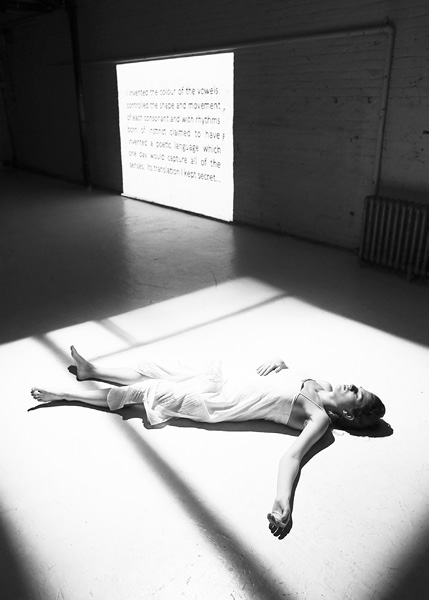
35 1/2
first performed on May 15, 2013
The Chocolate Factory Theater, Long Island City, NY
performed four times in 2013
AYNSLEY VANDENBROUCKE
Lauren Grace Bakst, Nelson R. Downend, Jr., Jennie Lai, Bobby Previte, Vicky Shick, Rebecca Warner
New York, NY
419240651a419240651y419240651n419240651s419240651l419240651e419240651y419240651v419240651@419240651g419240651m419240651a419240651i419240651l419240651.419240651c419240651o419240651m
movementgroup.org
35 1/2
AYNSLEY VANDENBROUCKE
In “35 ½,” three dancers and a percussionist grapple with opposites, which aren’t really opposites. They play with dancing + thinking, writing + reading, analyzing + immersing, performing + being. They are organized by structure, uncreativity, pleasure, modesty, excess and focus. Life enters in.
The last few years I’ve been making written dances. I’ve explored the ways words and meaning can be approached through formal choreographic tools. I’ve tried to see if words can exist in that open, not pinned down, state that movement often can. And, while I love this research, I felt like I was cheating by not admitting, and forcing myself to work with, the fact that I also still love DANCING. For “35 ½,” I tried to integrate these two different threads. The piece was made closely with my collaborators, and I chose them for their own passions and expertise within these areas. I also decided I needed to stop cutting off my life in order to make art. I needed these passions and experiences to wrestle together.
“35 ½” developed into a five-section dance. In the first section, three dancers improvise circles and grounded flowing movement, each within her own fuzzy box of light. In the second section, two of the women move in sharp, linear steps. One dancer has disappeared and, in her place, a sharp box of light appears on the wall. The box is filled with moving language appropriated from many sources, including choreographic and literary theory, books and novels. Another box of language appears. The dancers and boxes of language perform together. The words move as fast as the dancers; just as you cannot grasp all of the movement or the meaning in the movement, you cannot grasp the language.
In the third section, a dog and twelve guests of all ages from the local community appear. Colors, images and words saturate the Chocolate Factory Theater. Logic breaks down and there is a break in the formal performance. It is an interruption that becomes necessary to the progression of the piece. White light gradually washes out the color and one remaining dancer takes over. She is restrained in her fully traveling yet non-ecstatic quality. It’s as if she clears from the room, or her head, the language and chaos. In the fifth section, the other two dancers join. They improvise simple, spare movements. They are in white, slowly moving towards the white Chocolate Factory walls; black Chocolate Factory pipes stand out in their horizontal lines. Two dancers settle against the wall. They sit. They remain a few feet away from one another. They move closer. They sit in quiet, in a kind of nothingness. The lights expand. There is no close up. There is no language. Just a naked sense of time and, perhaps, no purpose.